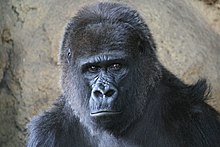Ueno Zoo
| Ueno Zoo | |
|---|---|
 Ueno Zoo entrance gate | |
 | |
| Date opened | 1882 |
| Location | Tokyo, Japan |
| Land area | 14.3 ha (35.2 acres) |
| No. of animals | 2600 |
| No. of species | 464 |
| Major exhibits | giant panda, Sumatran tiger, western lowland gorilla |
| Website | http://www.tokyo-zoo.net/english/ueno/main.html |
The Ueno Zoo (恩賜上野動物園, Onshi Ueno Dōbutsuen) is a zoo, managed by the Tokyo Metropolitan Government, and located in Taitō, Tokyo, Japan. It is Japan's oldest and most famous zoo, opened on March 20, 1882. It is a five-minute walk from the Park Exit of Ueno Station, with convenient access from Tokyo's public-transportation network. The Ueno Zoo Monorail, the first monorail in the country, connects the eastern and western parts of the grounds.
The zoo is located within Ueno Park, a large urban park that is home to several museums, a small amusement park, and other attractions.
History
World War II
Ueno Zoo's saddest time came during World War II. Shortly after March 1945 bombings of Tokyo, the Japanese placed former U.S. Army Air Force pilot Ray "Hap" Halloran on display naked in a Ueno Zoo tiger cage so civilians could walk in front of the cage and view the B-29 prisoner.[1] Japanese civilians, mostly women, looked upon him in sad silence.
The Japanese Army also ordered that all "wild and dangerous animals" at the zoo be killed, claiming that bombs could hit the zoo and escaping wild animals would wreak havoc in the streets of Tokyo. Requests by the staff at the zoo for a reprieve, or to evacuate the animals elsewhere, were refused. Ueno Zoo's three elephants at the time, John, Tonky, and Wanly (or Wang Lee) did not eat the poisoned food, and thus starved to death. The fate of Ueno's animals, particularly the elephants, has often been used in Japan as an example of the evils of war.
Recent renovations
Within the limits in which it operates, the Ueno Zoo attempts to provide the animals an environment similar to the natural habitat. In recent years, the old-fashioned cages of the past have been replaced with modern habitats, such as the "Gorilla Woods".
Animal population
As of March, 2003, the zoo has 422 species. The Sumatran tiger, and western lowland gorilla head the list of the zoo's population. Ueno has most variety of species on exhibition than any other zoo in Japan.
At some point, redistribution of the animals among Tokyo's other zoos (including Tama Zoo and Inokashira Nature Park) left Ueno without a lion. However, in response to public demand, Ueno borrowed a female from the Yokohama Municipal Zoo. [citation needed]
Principal animals

As of 2008, recent animals at the Ueno Zoo included:
- Giant panda (Ling Ling, Ueno's only giant panda, died of chronic heart failure on April 30, 2008, leaving Ueno Zoo without a panda for the first time since 1972.)[2] China has agreed to lend a male and female to Ueno[3].
- A Lesser panda (also known as the Red Panda)
Other animals have included the Sumatran tiger the Asiatic lion, the Western lowland gorilla, the Polar bear, the Asian elephant, the Reticulated Giraffe. and the White rhinoceros
Other animals
The zoo is also often home to zebras, Japanese macaques, red-crowned cranes, White-tailed eagles and King Penguins, along with goats, sheep, pigs, ostriches, and rabbits.
References
- ^ War trauma leads to efforts to reconcile | The Japan Times Online Article dated Wednesday, April 30, 2008 (Retrieved on June 28, 2009)
- ^ Giant panda Ling Ling dies at Ueno Zoo, Kyodo News, Japan Times, 2008
- ^ 胡主席 パンダ2頭貸し出しへ NHK Web site Retrieved May 6, 2008
